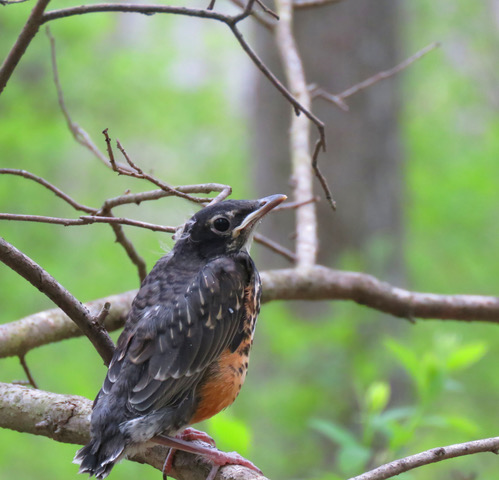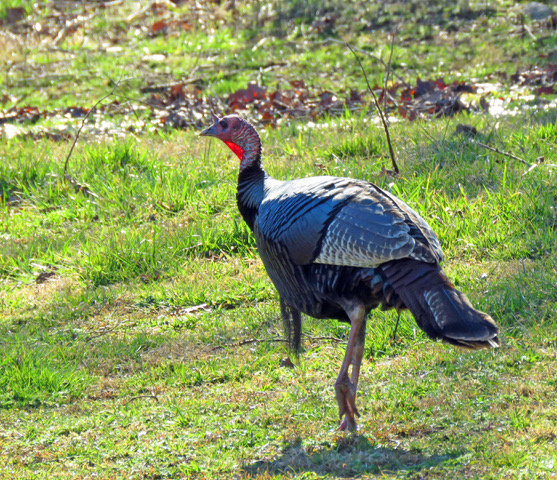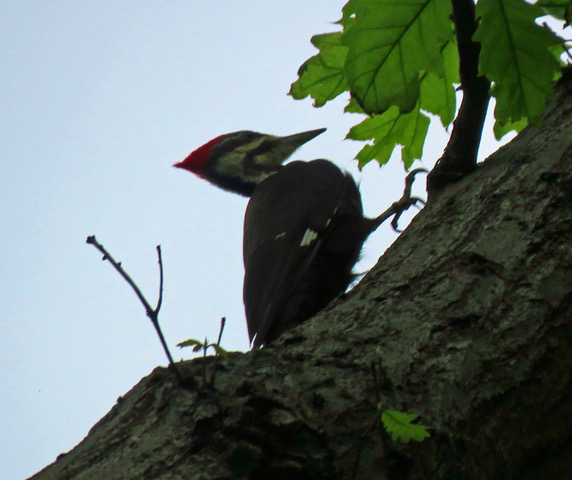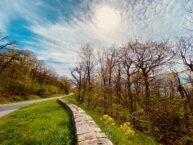“I wanted to live deep and suck out all the marrow of life…”
– Henry David Thoreau
Secret Vistas –
By Glynn Wilson –
CATOCTIN MOUNTAIN, Md. — Thousands of Americans are waking up to the advantages of traveling and immersing themselves in nature and even living full time in Recreational Vehicles, making the transition to a simpler, less materialistic nomad lifestyle. Over the past year, the option became less novel due to the coronavirus pandemic, and the Academy Award winning movie Nomadland clearly captured the nation’s attention.
It was like a lightbulb turned on in some peoples’ heads at least about the way they have been living, and many are looking for an alternative.
Related: Nomadland Steals the Show at Socially Distanced Academy Awards
RV life guru Bob Wells, who has been promoting the advantages of “Cheap RV Living” out West for years, was featured in the movie. He’s been preaching passionately about the advantages of the lifestyle for years.
In a recent video on the topic, he reiterated the six top reasons he says people should consider taking up the life.
Number one is economics, how much cheaper it is to live in an RV than to remain a slave to maintaining an urban or suburban house. Number two is freedom, the independence to move around according to the weather and other factors that can lead to number three, a higher qualify of life. In number four, he says the option gives people the freedom to reject some of the more materialistic and capitalistic aspects of a typical American life and, he doesn’t mention it but I add it, contribute to environmental sustainability with a lower carbon footprint.
That also leads to number five, the mental and physical healing that goes with living outside in nature as opposed to remaining walled up inside in a city or suburb, where a majority of Americans spent the past 13 months social distancing and socially isolated.
He also pitches the life based on number six, “community,” and he has been working for years to create that sense of community with campers in the Western U.S., although no one seems to be doing it in the Eastern U.S., a subject we are about to take on in a big way.
“There are ups and downs in any lifestyle,” Wells says in YouTube videos. “But overall this lifestyle can lead to a miraculous life.”
It’s not Bob’s preaching that is making the life catch on, however, and not exclusively COVID or the movie. But it is starting to catch on.
Two years ago it was reported that about a million Americans were already living in RVs. We suspect that number might double by this summer, although it’s too early to report that definitively. But the RV Industry Association recently released the results of a study and survey in March, and the data shows a definite uptick in RV sales at least.
“The growing demand from Americans hungry for the freedom to travel and experience the great outdoors is clear,” the study leads off. “More RVs made their way to RV dealerships across North America in March than in any prior single month.”
Wholesale, 54,291 RV units shipped this past March, a 5 percent increase over the previous record set in March of 2018. The March shipments also bring total RV shipments in the first quarter of 2021 to a record-breaking 148,507 units, the most RVs ever shipped in a single quarter and a nearly 10 percent increase over the previous record set in the first quarter of 2018.
“Over the past year, many Americans have rediscovered the great outdoors and the desire to get outside and live an active outdoor lifestyle. And many of these same people also discovered for the first time that an RV is the perfect way to get the most out of the great outdoors,” said RV Industry Association President and CEO Craig Kirby. “What our members have accomplished over the past year has been incredible. They overcame challenges presented by the pandemic and delivered a record number of RVs.”
When they looked at the motivations for purchasing an RV over the past year, they found the reasons were the same as they had always been. The love of road trips, a desire to travel in comfort, wanting to explore the “great outdoors,” and the ability to use an RV as a basecamp for other outdoor recreation activities.
“While many new buyers reported the pandemic did have some impact on their decision to purchase, the survey results showed ‘restriction on other travel due to COVID’ came in fourth from the bottom of the list. This really shows that people didn’t buy RVs over the past year because there weren’t any other options. They bought RVs because of the endless opportunities RVing provides to travel and get outdoors.”
A recent study from Go RVing echoed this growth, reporting that 11.2 million households now own an RV, up 26 percent over the past 10 years and 62 percent over the last 20 years. Even more importantly, nearly a quarter of current RV owners are now under the age of 35, and 84 percent of those younger owners plan to purchase a new RV in the next 5 years.
“The health benefits and mental wellbeing that come from being outdoors cannot be overestimated,” Kirby said.
Record Numbers of Campers
Park rangers in places like Shenandoah National Park in Virginia are also reporting record numbers of visitors and campers, with campgrounds filling up on the weekends and reservations at all time highs. The COVID year of 2020 was not the record year of all time for Shenandoah, as some rangers are saying, although some national parks reported decreases for 2020 due to park closures in the spring when the pandemic first hit and the national emergency was declared in mid-March.
It turns out that 1.7 million people visited Shenandoah National Park in 2020, an increase of close to 300,000 compared to 2019 visitation data collected by the National Park Service.
“It was an increase of 16.8 percent,” said Sally Hurlbert, management specialist for Shenandoah National Park. “That was huge because when you think about it, we were closed for six weeks in the spring, so to get that high of an increase was dramatic really.”
Shenandoah encompasses eight counties and more than 200,000 acres of protected public land, a prime destination in the Eastern United States for hikers and travelers with more than 500 miles of trails and 105 miles of paved road known as Skyline Drive.
“You can get up here and just drive on Skyline Drive, stop at the overlooks, look out at the views and get back in your car and keep going,” Hurlbert said. “And it also draws people who are wanting to get out and do more exercise. You can hike, go biking and once our lodge is opened up, people do like to come up and stay for a few nights.”
Hurlbert said Shenandoah is valuable in that way because it appeals to different people.
“It has a lot to offer,” she said. “There are so many different things to do.”
It also helps that the park is a two-hour drive from large metropolitan areas, such as Washington, D.C., and Northern Virginia.
When people are looking for a way to get out and recreate, Hurlbert said a lot of the time they don’t want to travel a great distance. With Shenandoah being easily accessible to many Virginians and others who live outside the state, people “flocked” to the park, Hurlbert said.
But meeting the demand for recreational opportunities while adhering to COVID-19 restrictions came with its own set of complications.
“On one hand we are super happy because we want to be a place that people can come and enjoy, but on the other hand when you get so many people coming, we do have issues,” she said.
When staff has to respond to a rescue, Hurlbert said, it adds to the level of stress because staff worried if they would contract COVID-19.
“Our staff has to be extra careful to be safe in situations like that,” she said.
Hurlbert was unaware if there was an increased number of rescue calls received at the park in 2020 compared to previous years, but did say that more people led to more traffic crashes, which led to more injuries.
One ranger in the park said the COVID crisis brought different kinds of visitors than usual, some less experienced at hiking and camping, and there have already been six helicopter rescues in the past year.
In Maryland state parks, where for years the average number of visitors and campers hovered around 7.1 million, that number jumped to a whopping 21.1 million in the COVID year of 2020.
Global Warming
Global warming is wreaking havoc on much of the world, the association admits, and the RV industry is experiencing similar woes that include a greater need for up-to-date travel information for up to 10 days in advance. For instance, seasonal flash flooding is becoming more prevalent at certain destinations, and RV travelers are specifically at risk.
The fluctuations in temperature that accompany global warming and climate change make staying warm in the winter and comfortably cool in the summer a challenge. When temperatures drop to sub-zero levels, it is necessary for travelers to rely on high-quality insulation and heating accessories capable of seeing them through flash-freezes. Summer heat zones are becoming geographically broader, and the peak temperatures are remaining peaked for longer periods of time. Consequently, air conditioning is becoming a critical feature for all RVs, and the ability to affordably run electricity at parking stations, state parks, and RV camps is a growing concern.
New American Journal
Of course our readers know that we have also been living the Mobile Journalism (MoJo) life for the past seven years, literally publishing a news site on the web from a media camper van on the road.
Perhaps due to the realizations hitting people because of the pandemic, and maybe because of the eye-opening revelations about the life in the movie, this idea might begin to catch on even more going forward. Motivated by what we are seeing out here, as well as the creative take in the movie, we are planning some updates and changes to our mission.
While my idea for selling a house in the South and moving into campgrounds around the nation’s capital was not motivated by necessity — as was the case with the character Fern in the film — it was similar to the view of Bob Wells about living outside in nature, but being close enough to the federal power center of Washington to keep up with key trends in how the United States is being governed.
Plus, I was inspired more by Henry David Thoreau’s view of life than Bob Wells, something I wrote about early on.
Related: An Update on Thoreau’s Necessities of Life
Going forward, we are going to specialize even more in covering industry trends about this lifestyle, and we plan to interview more people out here in the campgrounds of the East and shoot more video footage of the places we go.
While I’ve mostly just been traveling around taking pictures of these beautiful places and writing news stories — and we quit producing YouTube videos a few years ago when Google stopped us from running ads on our videos — we are getting back into the video business with an updated philosophy. One weakness of the movie, in my view, was the mediocre nature of the cinimaphotography. Some of that may have been on purpose to fit the plain, everyday sameness of the life of the character, some of it may also have been due to the film crew’s lack of experience in filming the great outdoors, and also because of budget and time limitations.
I have been scouting the campgrounds of the Eastern U.S. for the past seven years, and I now have an experienced grasp of the places to go and times to get the best shots.
Perhaps I should have been conducting more videos with people out here in the campgrounds too, but that was not the original plan. We are now making it a key part of the plan, and we start with this simple little video in which we interviewed a young couple in Shenandoah National Park traveling in a plain, simple fixed up van and teaching English as a second language to provide the budget for the trip.
So feel free to come along on our journey. Sign up for our email list. Subscribe to our YouTube channel. Tell your friends about it on social media. And help us fund our travels so we can get even better material. Who knows? Maybe we will make our own movie.
More Photos

A distressed bird during the Spring migration in Catoctin Mountain National Park in Maryland: Glynn Wilson
















